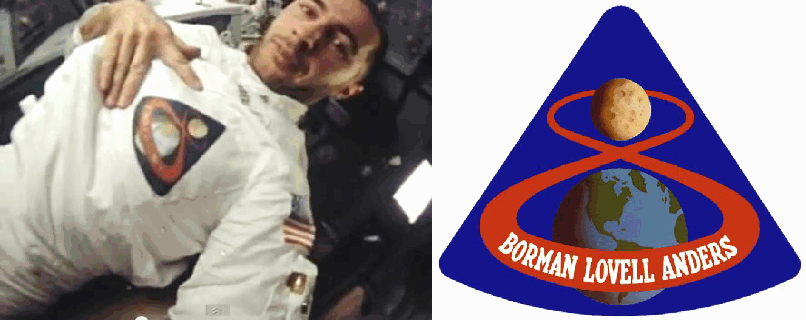
This page deals about excerpts of videos of different missions.
A part at least is from Apollo 8, for an astronaut shows the Apollo 8 patch.
But there also are images from other missions.

It starts with this view of a separation of stages of the saturn rocket.
We first see much smoke, then the smoke fades away.
Then we see much smoke again!
But why, for what reason?
What can explain that suddenly we see much smoke again?
Strictly nothing, this is fantasy!
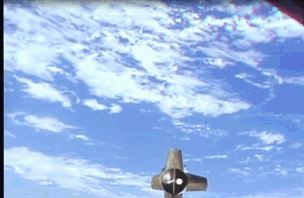
Then we see what I suppose to be the sequence of docking of a space module.
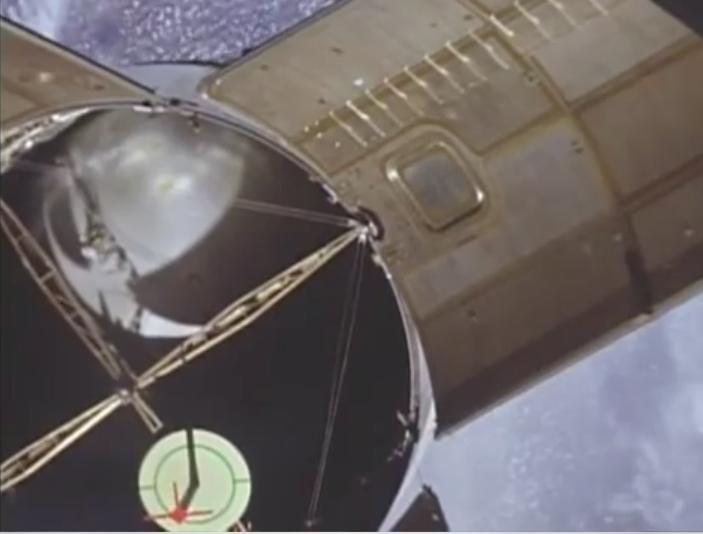
When the CM is close to the LM, we see this view.
In particular we see the docking target which allows the CM to make a perfect alignment with the CM.
Let's make a close-up of it.
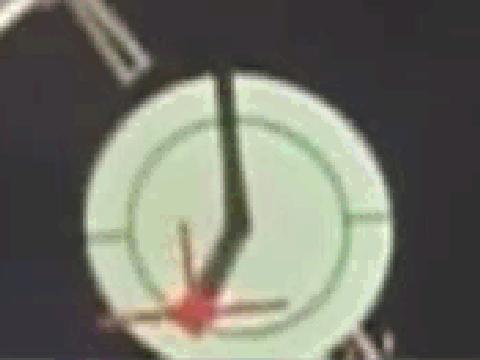
The two branches we see on this close up of the alignment target make me think of a clock.
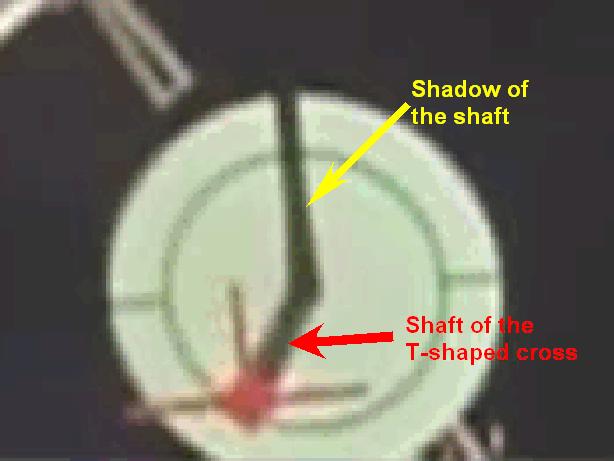
But someone told me that I was dumb not to see that it was the alignment T-shaped shaft and its shadow in fact, and that we were thus seeing something normal.
Really?
Let's see closer.
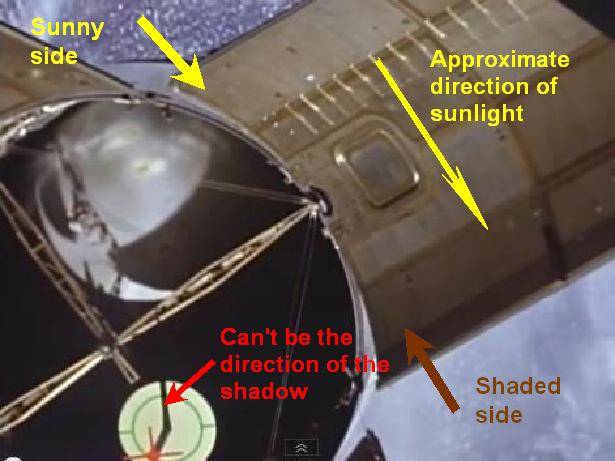
The upper part of the space module on the image appears sunny, while the lower part appears rather shaded.
The conclusion is that the sunlight approximately has the direction indicated by the yellow arrow; if you observe the big luminous reflection on the upper part of the space module, you can see that its orientation is such that the direction of the sunlight is close to the direction I have represented with the yellow arrow (the big sun reflection on the upper part allows to deduce the direction of the sunlight); it is in contradiction with the supposed shadow of the shaft which has a direction which is almost oppose to this direction.
Now, Apollo believers have told me that only the upper part of the space module was convex, and the lower part, on which the target is attached, would be concave; the shadow of the shaft would not directly come from the sunlight, but from the reflection of the sunlight on the side of the lower concave part; even so, given the regular shape of the lower concave part, the reflection of the sunlight would still have the direction of the sunlight, but opposed to it; given the direction of the sunlight (in particular evidenced by the luminous reflection on the upper convex part), the direction of the shaft's shadow is still incorrect; it should be more turned counter-clockwise (on the left).
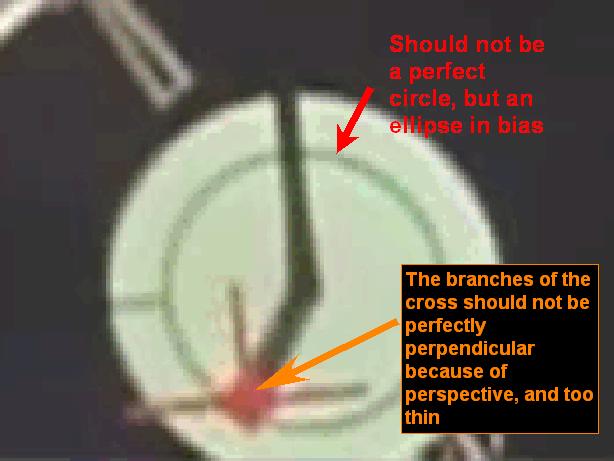
Then the way that the shaft appears shows that the space module is not currently facing the CM, but a little turned relatively to it.
Consequently the circle of the target should not be a perfect circle but an ellipse in bias.
And the branches to the T-cross should not be perfectly perpendicular, but show an angle.
Furthermore the branches of the T-cross are too thin to be the real T-cross of the alignment shaft.
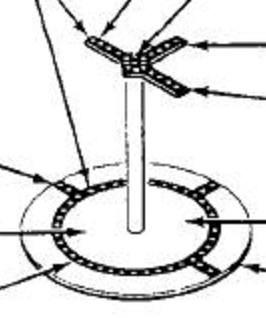
Normally, as this schema shows, the branches of the T-cross are thicker to be well visible.

The cross we see rather looks like the alignment reticle of the optical alignment system.
Furthermore, unlike the T-cross of the shaft, the branches of the reticle always remain perfectly perpendicular.
But let's forget about these problems and suppose it is really the alignment shaft (what else could it be?).
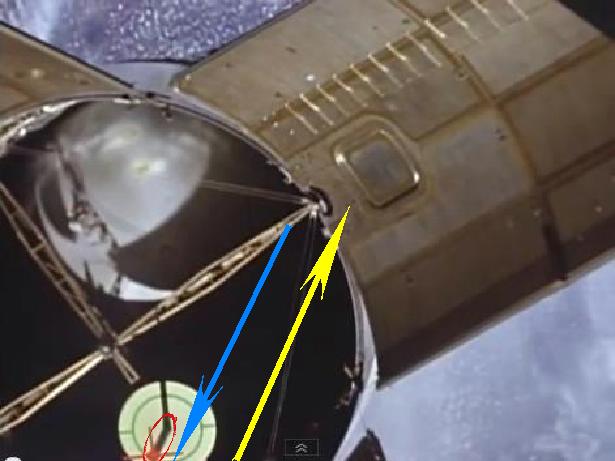
The way that the alignment shaft appears shows that the space module is turned in the direction indicated by the blue arrow relatively to the CM.
So, in order to correct the disalignment, and make the space module face the CM, the space module should turn in the direction indicated by the yellow arrow.
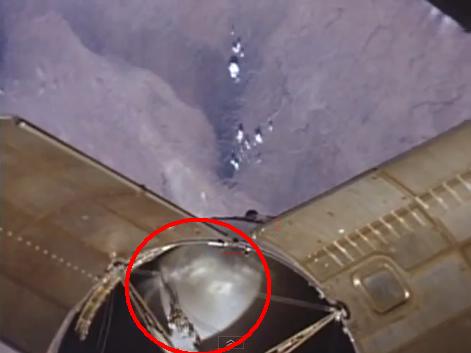
Now, I ask you to concentrate on the luminous sun reflection I have circled on the animation I am going to show you.
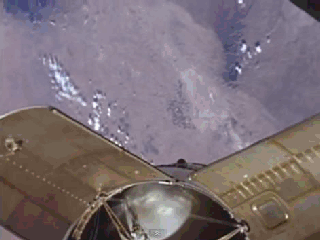
Observe attentively....
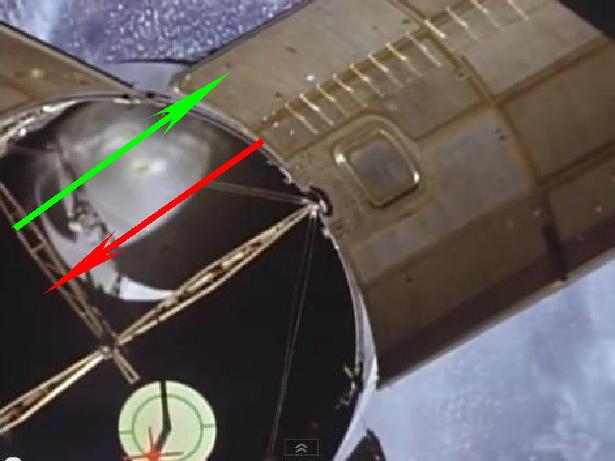
If you observed attentively, you could see that the luminous reflection moves in the direction indicated by the green arrow on the space module.
That means that the space module is currently turning in the opposite direction, that is along the direction indicated by the red arrow.
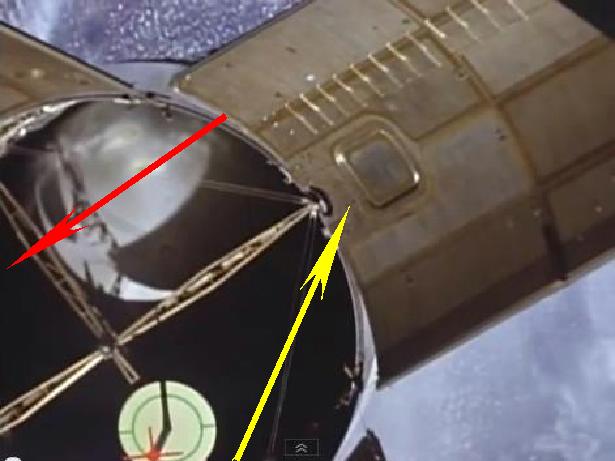
So, let's summarize: In order to correct the disalignment indicated by the alignment shaft, the space module should turn in the direction indicated by the yellow arrow, but the move of the luminous reflection on the space module conversely shows that the space module is turning in the direction indicated by the red arrow...which is almost opposite!
In short, the way that the space module turns is going to aggravate the disalignment, and not correct it!
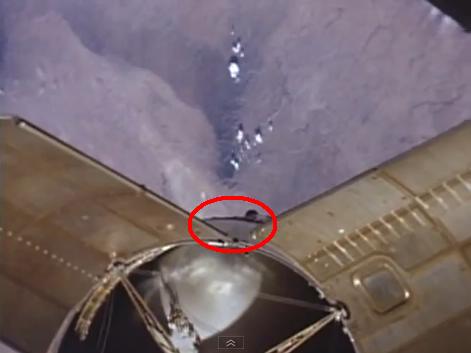
There is a bonus.
I now ask you to concentrate on this view of the lower part of the space module we can see between its wings, and that I have circled on this view.

Observe attentively...

If you paid attention, you could see that there is an element of the lower part which moves between the two wings of the space module.
It shows that the lower part of the space module is turning, but the upper part is not.
How can the lower part of the space module be turning independently of its upper part?
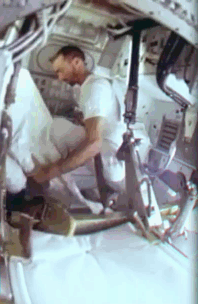
Then we see an astronaut slipping into his suit.
It seems completely obvious that there is a serious draft as he pulls his suit, that the scene cannot just happen in a simple weightless environment; his suit wriggles in an abnormal way, which does not simply come from the astronaut's moves..
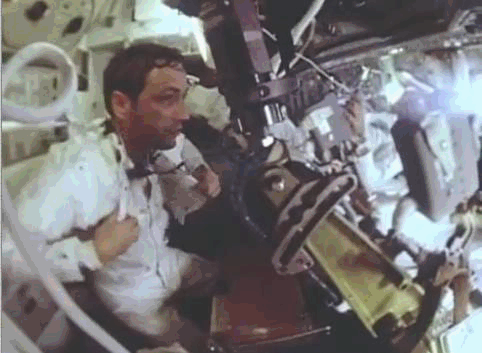
In this scene, we see a piece of his headset which does not move like it was in a weightless environment, but rather like it was submitted to its weight; it makes a pendulum move.

The command module has hardly separated from the lunar module that it is already in vertical attitude, in attitude of free fall.
In reality the change of attitude of the command module would be more progressive, for it first needs to decrease its orbital speed.
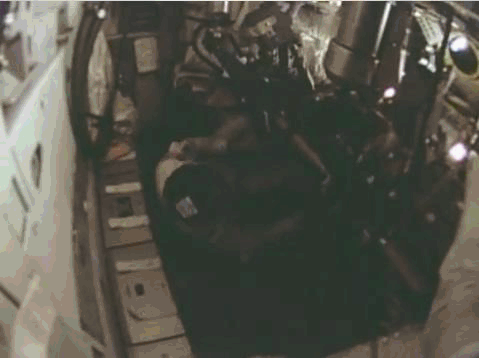
In this sequence, we see the astronaut making a bag pass over a wall by pushing it up and on the side.
The way he is placed, he cannot give it a push down after the bag has passed the wall.
So, normally, in the weightless environment, the bag should go on with a horizontal move after it has passed the wall.
Instead of that, we see it go down, like it was submitted to its weight.
On earth, this sequence would look normal, but, in the supposed weightless environment, it is much different!
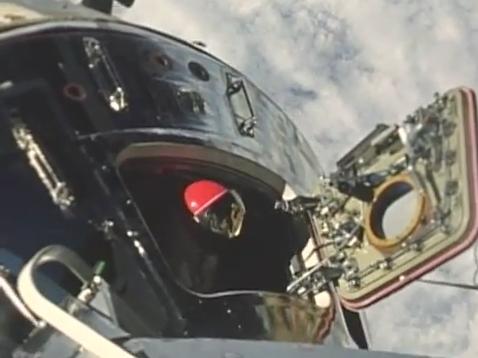
Then we see an astronaut go outside the CM.
The first thing which strikes me is that the astronaut has no breathing system; how can he breathe at this altitude without breathing system?
He opens the door of the CM, but this door seems rather strange.
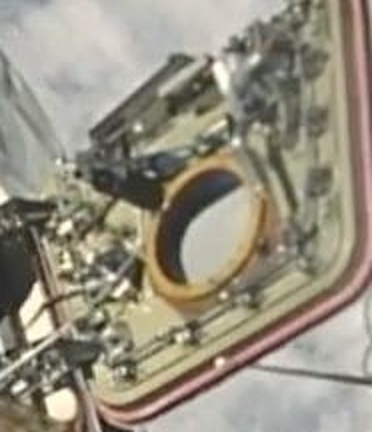
Why is there all this stuff on the door, what can it be its purpose?
It certainly does not help to open the door!
Some have told me that it was allowing to open the door faster; but, if there was a such mechanism, it would be installed on the hinge, not on the whole door!
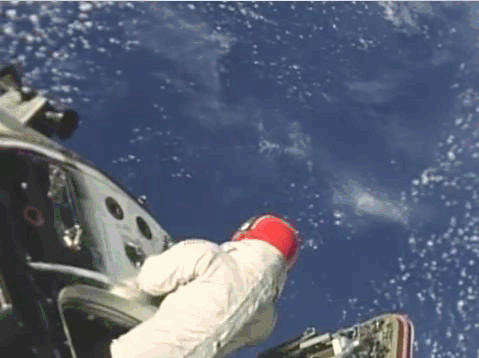
Then we see the astronaut apparently trying to fix a cable on the CM.
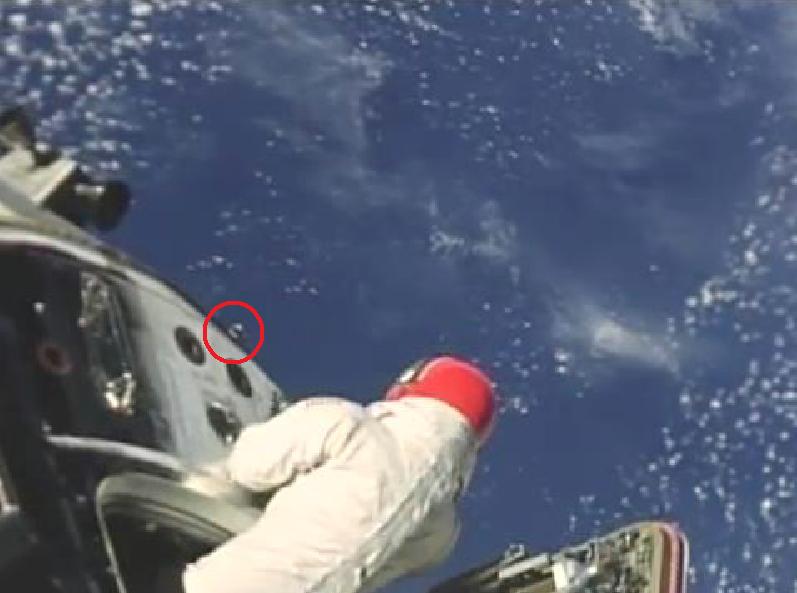
We see a sort of lug attached to the CM, I have circled, which probably allows to fix a cable on it.

Now attentively watch this lug on the video...
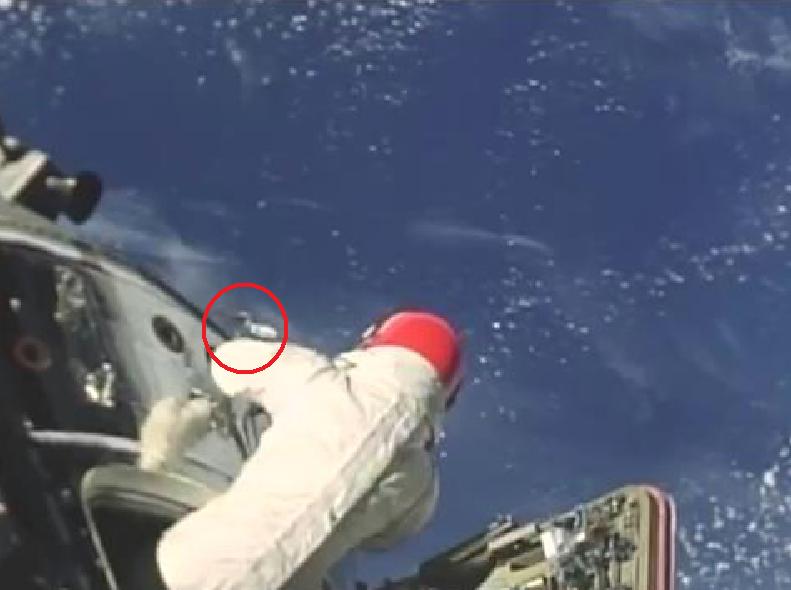
...The lug suddently unexpectedly moves away from the CM.
Strange that it could so easily be detached from the CM!
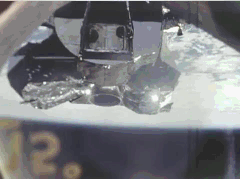
On this view, the LM turns to orient more and more its engine toward the CM.
In fact this maneuver is senseless, for a docking maneuver always consists in making the two spacecrafts face each other's nose, never in making one turn to show its engine to the other.
It's even dangerous, for, if ever the lunar module was setting his engine on, it could burn the command module.
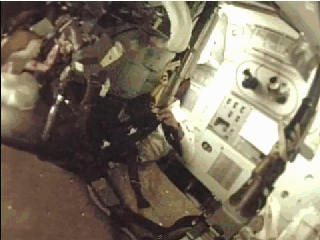
What the astronaut on the left is holding in his hand seems to be a camera, but it is a light meter in fact.
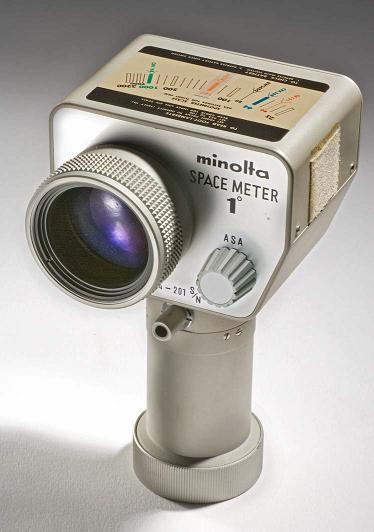
This light meter allowed to make an automatic adjustment of the camera according to the luminosity of the place that the astronaut wants to take in photo, as soon as Apollo 11.
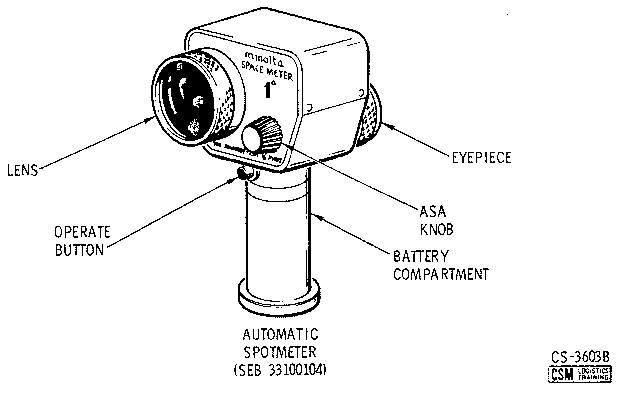
This schema explains the various parts of this light meter.
There is an eyepiece on the back of the device that the astronaut looks through to aim at the place that the astronaut wants to take in photo so to get its luminosity.
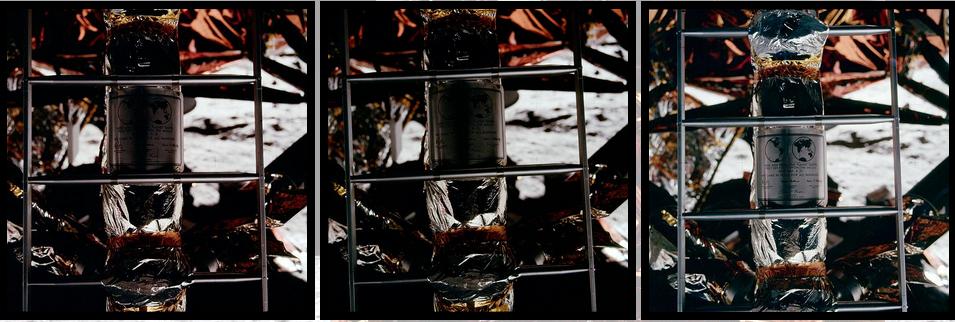
But, if the astronauts of Apollo 11 had this light meter, why didn't they use it to take the commemorative plaque in photo, and just adjust the luminosity of the camera with the indication of the light meter?
The three shots of the commemorative plaque should have been clear, not just one (well more or less).
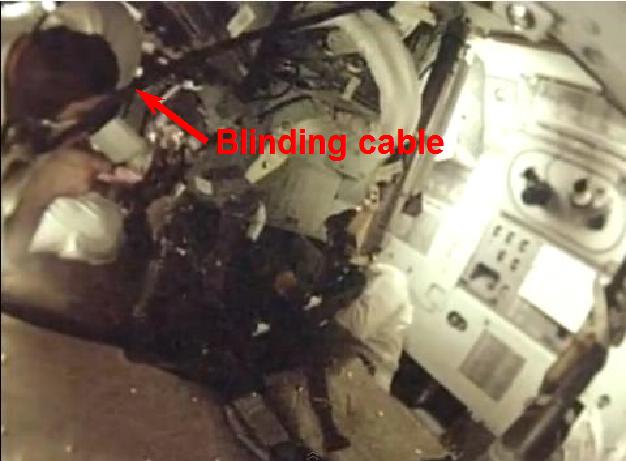
Let's go back to the scene in Apollo 8.
There is a cable, I show with an arrow, which comes between the light meter's eyepiece and the astronaut, and which obviously hinders him for aiming at the place he wants to get the luminosity of.

Why didn't the astronaut push away this annoying cable and and why did he let it disturb his light measure instead?
Was this light measure really serious? Wouldn't it be a phony device?
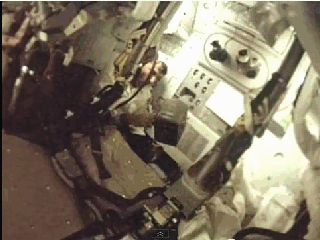
I was sure that there was a trick with an astronaut manipulating a cube; however I could find no flagrant anomaly in his way of manipulating the cube, when my eye caught the diskette he is holding in his left hand.
The diskettes of this time were bigger than the diskettes which were used later.
The anomaly only appears on one image of the sequence, so it requires much attention to spot it.
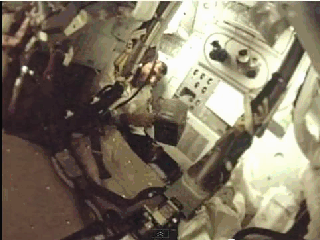
So, you can see it better, I have duplicated this image several times in this new animation.
What can we see?
We can see, on the image I have duplicated, that the diskette appears quite bigger than on the rest of the video.
So the diskette magically grew in the hand of the astronaut?

On this sequence, we can see the astronaut through a piece of glass which bears a graduated scale.
That the marks become no visible when passing over a dark background is normal, but, when there is a clear background behind, as the graduated scale is before this clear background, the marks should be perfectly visible.
Yet, you can see that there is a mark (10) that there is a clear background behind (the astronaut's helmet), and yet this mark does not appear entirely visible, partially erased instead.
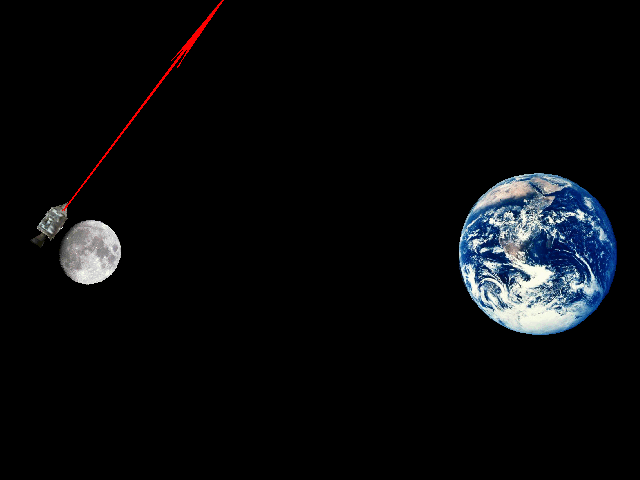
The earth has a fixed position relatively to the moon.
If the CM sees the earth rise on the videos of Apollo, it is only because of its rotation around the moon.
If the CM was stationary relatively to the moon, it would always see the earth at the same height relatively to the lunar horizon.

In this sequence we can see the earth move up relatively to the lunar horizon because the CM is moving forward.
So, we should see the artefacts of the moon change as it is moving...but they are the same all along this sequence.

This view of the LM as it is leaving the CM to start its travel to the moon is illogical.
The LM does not leave the CM this way, this is fantasy.
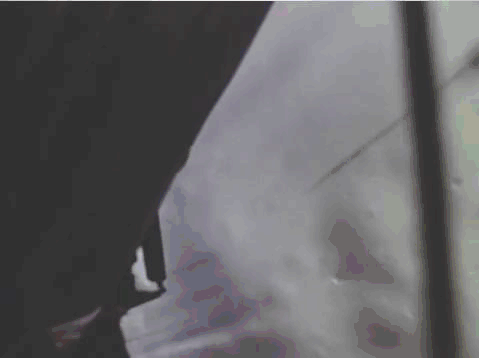
Then we see the final sequence of the landing.
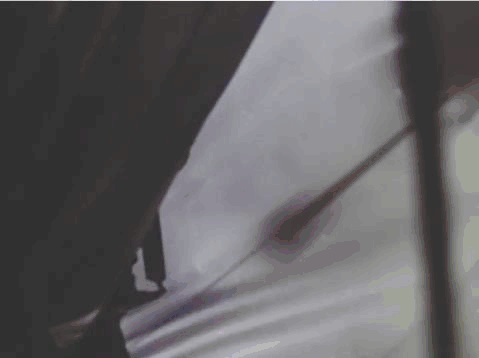
We see on the lunar ground what is supposed to be the shadow of the LM.
Let's see closer the shadow of the footpad.
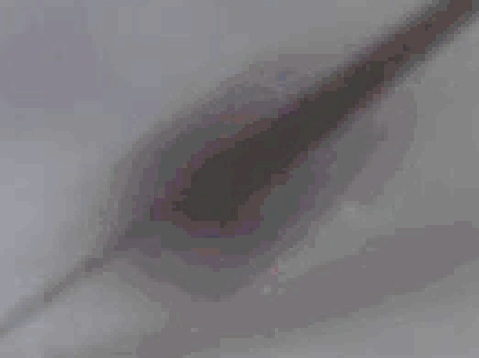
This shadow is very strange.
Why is the shadow of the footpad not as dark as the one of the strut?
And we see this shadow not as it was the projection of the back of the footpad, what it should normally be, but the one of the front of the footpad!
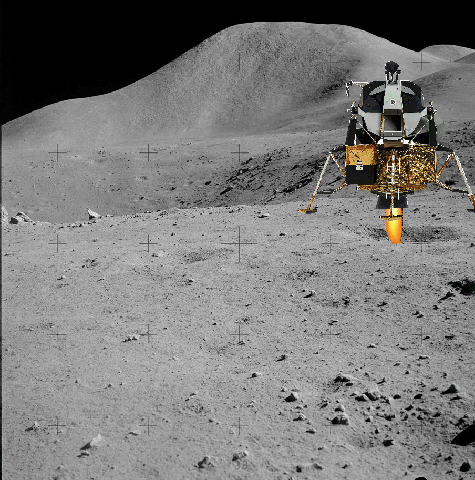
Normally, when the LM wants to land, it should first stop moving relatively to the lunar ground, and then descend vertically as it is perfectly stationary relatively to the lunar ground; it is absolutely essential for the safety of the landing!
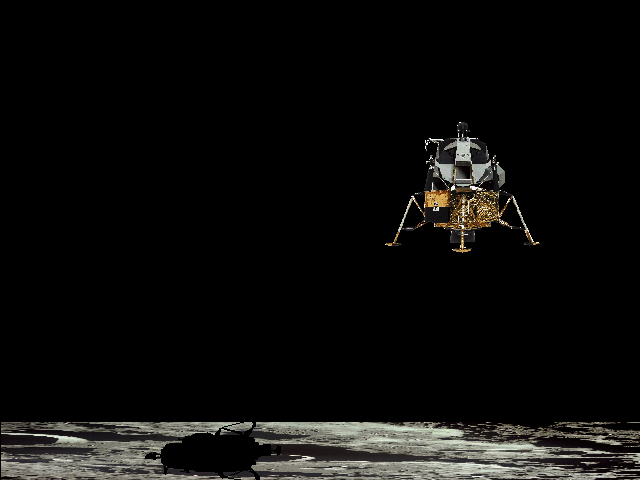
If the LM is stationary relatively to the lunar ground when it lands on the moon, then, from the LM, the astronauts see the lunar artefacts move toward the LM's shadow as the LM lands.

As the LM's shadow comes from the right top corner of the image, the lunar artefacts should logically move from the bottom left corner to the top right corner of the image...yet, we see them move in all directions, save this direction!

That means that the LM is not stationary relatively to the lunar ground as it lands on it, but moves incoherently in all directions as it lands on it; I don't say I show what the LM exactly does in my animation, but, what's sure is that the LM does not land stationary relatively to the lunar ground!
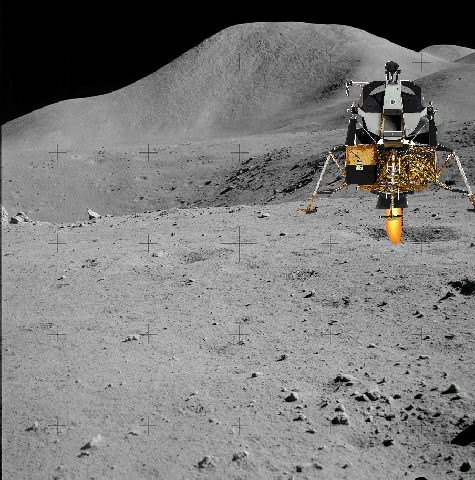
The consequence that the LM does not land stationary relatively to the lunar ground is that it has every chance to tip over when it touches the lunar ground!
If it does not do it on the video of Apollo 16, it is because this landing is imaginary.
Note that I have kept the engine burning on this animation, when it should normally have been shut off shortly before touching the ground because I don't buy that the astronauts had securely the time to shut off the engine when they saw the probe lights go on.

Apollo is definitively the realm of absurdity!





















